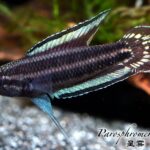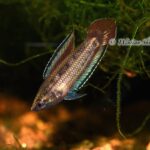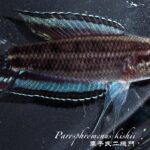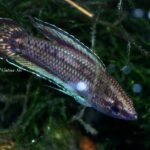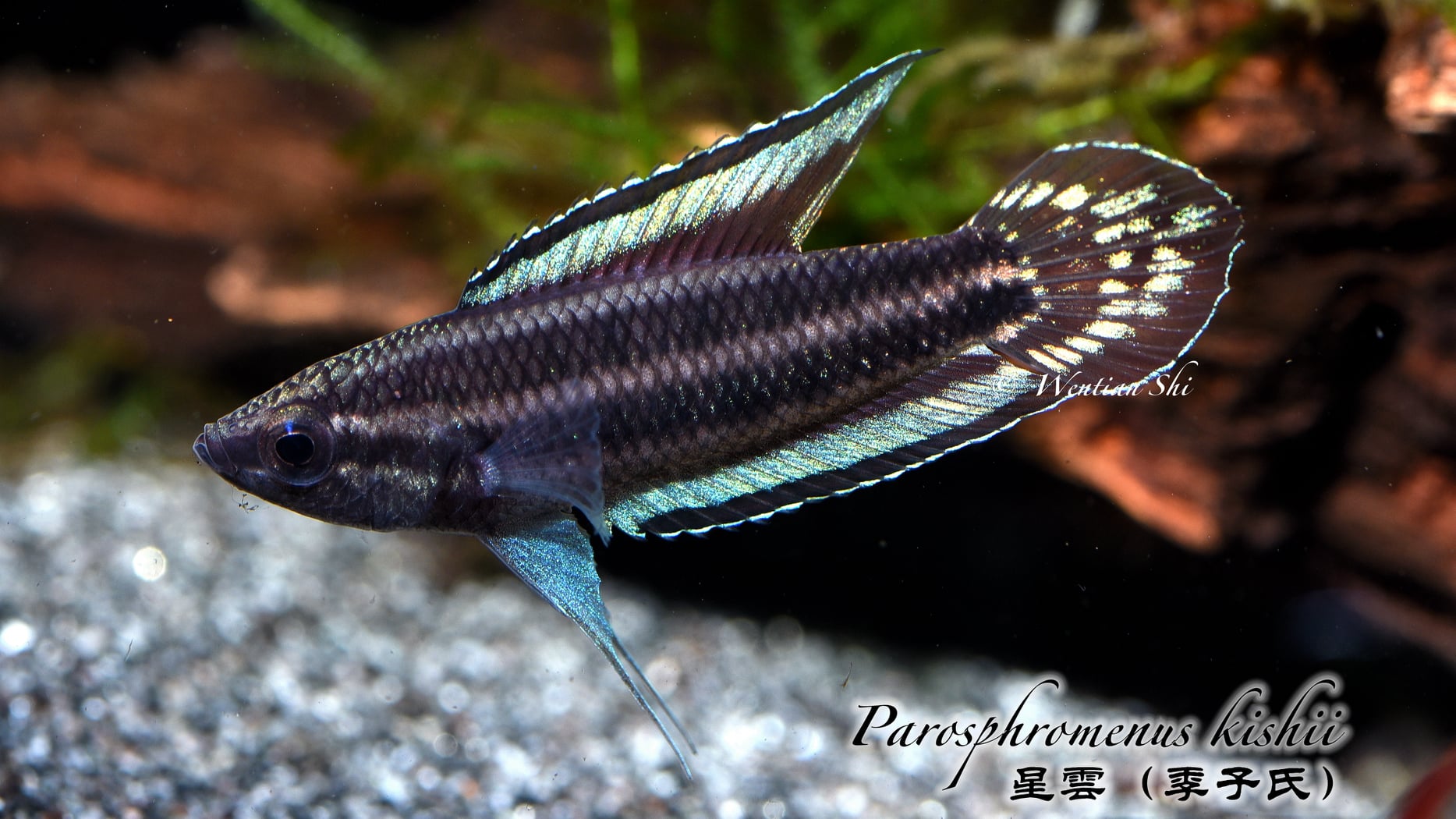
Parosphromenus kishii
First describtion:
First describtion: November 2021 – WENTIAN SHI, SHUJIE GUO, HARYONO HARYONO, YIJIANG HONG & WANCHANG ZHANG
Zootaxa 5061 (1): 071–092
Characteristics: Parosphromenus kishii, sp. nov.,is distinguished from its congeners by the following unique com-bination of characteristics: the unique caudal fin coloration, consisting of a uniformly reddish background; irregular faint turquoise blotches of differing sizes scattered on the central region of the caudal fin, vaguely forming a band without clear outline; caudal fin pointed rhombic shape; a long dorsal fin with XIII–XIV spines and 7–8 segmented rays (total 20–22, mode 20); anal-fin rays XII–XIII, 9–10 (total 22–23, mode 22); a broad light bluish iridescent band in dorsal- and anal-fin; pelvic fin and filament uniformly bluish.
Similar species: Parosphromenus kishii can be easily distinguished from all other Parosphromenus by its unique reddish caudal fin with an irregular faint turquoise pattern and pointed rhombic shape
Occurence/Distribution: The species was recorded by H. Kishi in Kalimantan Tengah as early as Nov. 1999. Currently it is only found in a single river, which is severely disturbed by human activities (Fig. 6). Most of the nearby regions have been converted into oil-palm plantations. Thus, we have yet not been able to record this species outside this single river. There are still some remote locations with better potential, which have not been explored in the last survey. Further studies will be necessary to clarify the distribution of this endangered species.
Threat: Parosphromenus kishii sp. nov. is confined to a single river, which now functions as a natural irrigation canal for a large oil-palm plantation. The habitat is extremely impacted. Any further works at the plantation may lead to dredging and expansion of this river, which may eradicate the only known population of this species. Thus, following the IUCN Red List Categories and Criteria (ver. 3.1), we propose that this species be listed as Critically Endangered B2ab (iii, v), based on its very restricted distribution within a single river running through an oil-palm plantation (<50 km2) with only a single known location and the extremely high likelihood of becoming extinct due to the potential works of surrounding oil-palm plantations. Immediate in-situ or ex-situ conservation is highly recommended for this species.
Discovery/First import: The species was recorded by H. Kishi in Kalimantan Tengah as early as Nov. 1999
Trade:
Care/Breeding:
Behaviour/Particularities:
Different forms of the caudal fin shape can be found within Parosphromenus kishii: a pointed rhom-bic shape in most specimens (44 out of the 50 collected adult specimens), rhombic with a convex in the middle in specific specimens (2 out of 50) and lanceolate with a projected short filamentous tip in certain older adults (the me-dian ray branched instead of simple, 4 out of 50) (Fig. 7 A–C, G). Except the convex morph (Fig. 7 G), which might be an aberrant one, other phenotypes have been preserved in the next generation. We observed again in the same batch of F1 from a single pair, three different morphs of caudal fin shapes: round, pointed rhombic and lanceolate with a projected short filamentous tip (Fig. 7 D–F). The rays of the fin are not damaged in the examined specimens, and these shapes are not aberrant due to regrowth following injury. Thus, these distinct caudal fin shapes are most likely a potential polymorphism in this species.
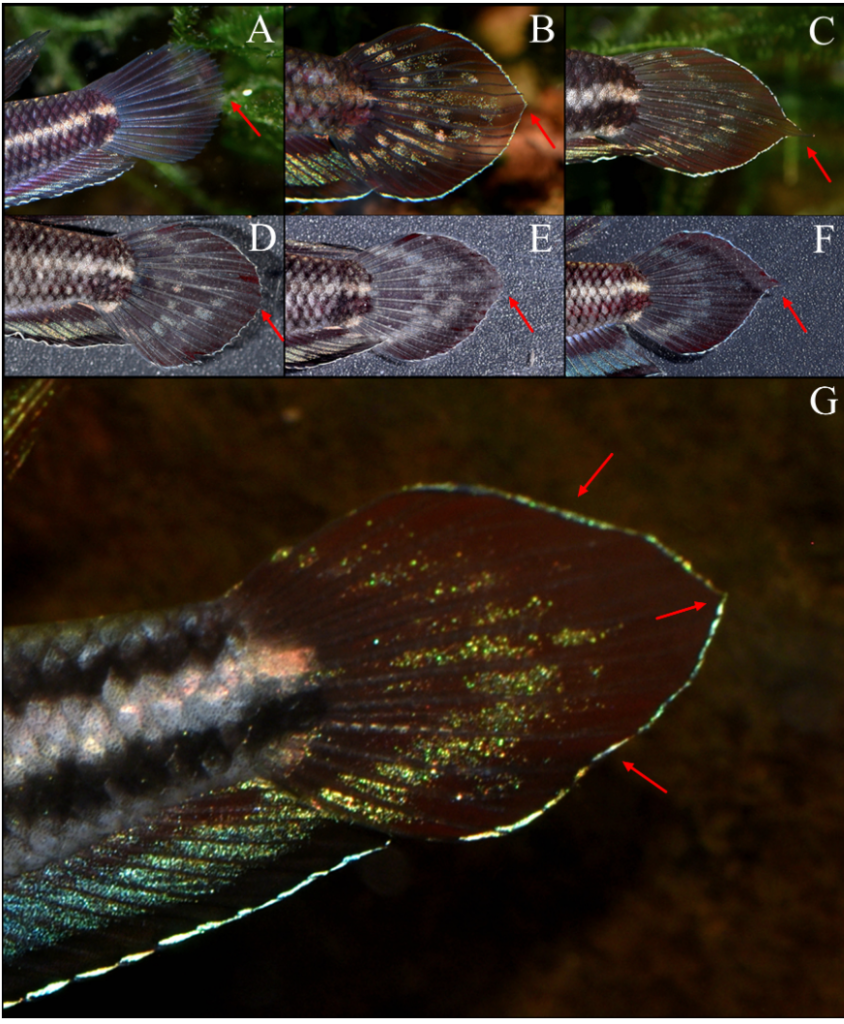
FIGURE 7. (A) The rounded caudal fin of juveniles: posterior edge of the fin smoothy rounded, not pointed; not preserved; (B). The most common rhombic caudal-fin shape in adults, posterior edge of the fin projected outwards into a pointed rhombic shape, SJD KA2081, from type locality; (C). The third variant of the caudal-fin shape, the median ray branched and elongated into a short filament in some adults, SJD KA2081, from type locality; (D) The rounded caudal-fin shape in F1 adults (offspring of the male in Fig. 5 C); (E) The pointed rhombic caudal-fin shape in F1 adults (offspring of the same clutch of the male in Fig. 5 C); (F) The spade-shaded caudal-fin shape with a short filament (median ray branched) in F1 adults (offspring of the same clutch of the male in Fig. 5 C); (G) Another variant of the caudal-fin shape in adults, the middle part of the posterior edge of the caudal fin aberrantly elongated outwardly into a center convex rhombic shape, but without filament; same fish with Fig. 5 C, not preserved. (laterally inverted).


